(資料科學學習手札112)Python+Dash快速web應用開發——表單控制元件篇(上)
阿新 • • 發佈:2021-03-15
> 本文示例程式碼已上傳至我的`Github`倉庫[https://github.com/CNFeffery/DataScienceStudyNotes](https://github.com/CNFeffery/DataScienceStudyNotes)
# 1 簡介
這是我的系列教程**Python+Dash快速web應用開發**的第九期,在之前三期的教程中,我們針對`Dash`中經常會用到的一些靜態部件進行了較為詳細的介紹,從而get到在`Dash`應用中組織靜態內容的常用方法。
而從今天的教程開始,我將帶大家來認識和學習`Dash`生態中非常實用的一些**互動式**部件,配合回撥函式,可以幫助我們構建一個形式豐富的可接受輸入,並反饋輸出的互動式應用,今天要介紹的互動部件為**表單輸入**類部件的基礎知識,下面來學習吧~
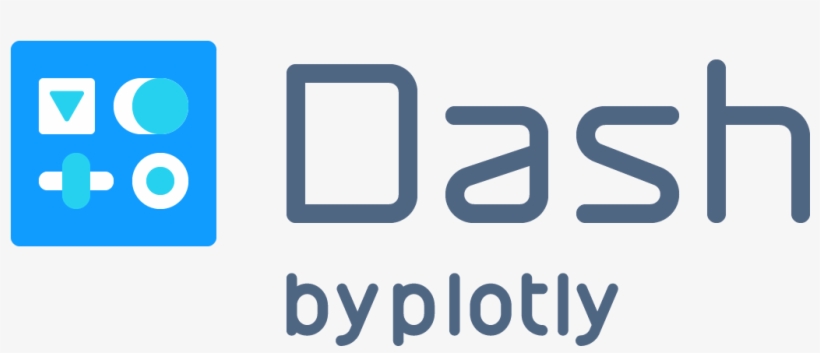
圖1
# 2 Dash中常用的表單輸入類互動部件
**互動部件**跟之前介紹的一系列**靜態部件**的區別在於它們不僅具有供使用者互動操作的特點,還承擔了接受使用者輸入,並傳遞這些輸入引數的作用。而網頁開發中,**表單輸入**類部件則是互動部件中最常用到的。
在`Dash`生態中常用到的表單輸入類互動部件有:
## 2.1 輸入框部件Input()
其實在之前的教程內容中我們已經使用過很多次輸入框部件`Input()`了,而我比較推薦使用的是`dash_bootstrap_components`中封裝的`Input()`,它相較於`dash_core_components`中自帶的`Input()`擁有更多特性。
除了幾乎所有部件都具有的`id`、`className`以及`style`引數之外,`Input()`中還有一個特殊的引數`type`,它的不同取值從根本上奠定了`Input()`的角色,常用的有:
- **text、password、search**
當`Input()`的`type`引數取值為`'text'`、`'password'`以及`'search'`之一時,它分別扮演文字輸入框、密碼輸入框以及搜尋框等角色,也擁有了一些特別的常用引數&屬性:
`value`屬性對應它當前的輸入值;
`placeholder`用於設定未輸入時輸入框內的提示文字;
`maxLength`用於設定最多可輸入的字元數量;
`n_submit`用於記錄游標在輸入框內部時鍵盤`Enter`鍵被點按的次數;
`debounce`設定為`True`時會強制每次使用者按下`Enter`鍵或點選其他部件時才同步`value`值給後臺`Dash`服務。
`valid`和`invalid`引數都接受Bool型引數,分別用來控制輸入框顯示正確狀態以及錯誤狀態,我們可以在檢查使用者名稱、密碼等是否正確時通過回撥輸出設定這些引數為True來告知使用者相關提示資訊。
我們來通過下面的示例來直觀感受這些特性:
> 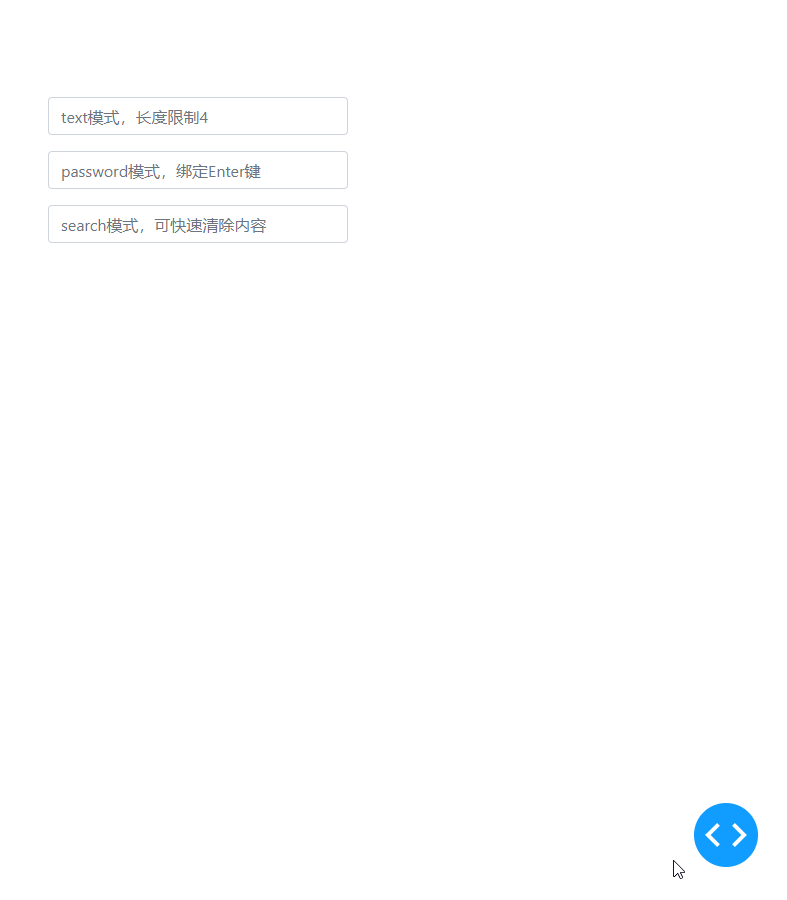
圖2
- **number、range**
當`Input()`部件的`type`屬性設定為`'number'`時,它便搖身一變成了數值輸入框,並擁有了一些特殊的引數&屬性:
`min`與`max`引數用來約束數值輸入框的輸入值上下限;
`step`引數用來設定數值輸入框右側上下箭頭點按一次後數值變化的步長
而當`type`設定為`range`時就更有意思了,我們的`Input()`這時變成了一個滑桿,也是通過上述三個引數來限制範圍和拖動的步長值。
> app2.py
```Python
import dash
import dash_bootstrap_components as dbc
import dash_html_components as html
from dash.dependencies import Input, Output
app = dash.Dash(__name__)
app.layout = html.Div(
dbc.Container(
[
dbc.Input(id='input-number',
placeholder='number模式',
type='number',
min=0,
max=100,
step=0.5,
style={'width': '300px'}),
html.P(id='output-number'),
dbc.Input(id='input-range',
placeholder='range模式',
type='range',
style={'width': '300px'},
min=0,
max=100,
step=10,),
html.P(id='output-range')
],
style={'margin-top': '100px'}
)
)
@app.callback(
Output('output-number', 'children'),
Input('input-number', 'value')
)
def output_number(value):
return value
@app.callback(
Output('output-range', 'children'),
Input('input-range', 'value')
)
def output_range(value):
return value
if __name__ == '__main__':
app.run_server(debug=True)
```
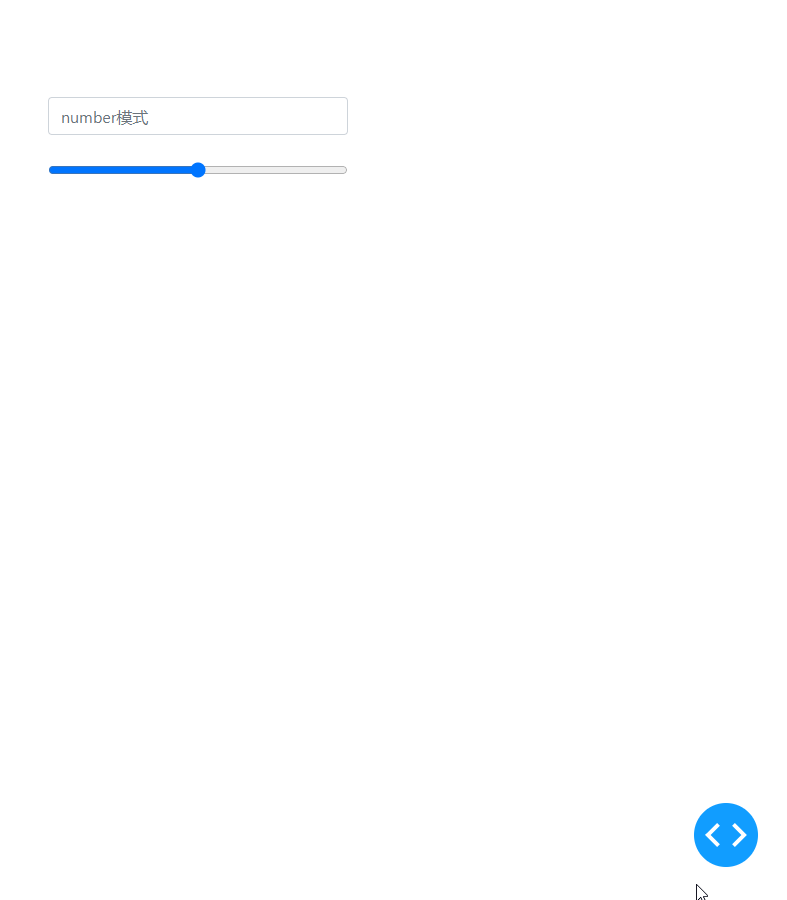
圖3
## 2.2 下拉選擇部件Dropdown()
接下來我們來深入學習之前也使用過很多次的下拉選擇部件`Dropdown()`,直接使用`dash_core_components`中的`Dropdown()`即可,它的主要屬性&引數有:
`options`用於設定我們的下拉選擇部件中顯示的選項,傳入列表,列表每個元素為字典,必填鍵有:`'label'`,用於設定對應選項顯示的標籤名稱;`'value'`,對應當前選項的值,也是我們書寫回調函式接受的輸入;`'disabled'`,一般情況下不用設定,除非你想指定對應選項不可點選就設定為True;
`multi`,bool型,用於設定是否允許多選;
`optionHeight`,用於設定每個選項的顯示畫素高度,預設35;
`placeholder`,同`Input()`同名引數;
`searchable`,bool型,用於設定是否可以在輸入框中搜索下拉選項;
`search_value`,可用作回撥的輸入,記錄了使用者的搜尋內容;
`value`,記錄使用者已選擇的選項,單選模式下為對應單個選項的`'value'`值,多選模式下為對應多個選項`'value'`值組成的列表;
> app3.py
```Python
import dash
import dash_bootstrap_components as dbc
import dash_html_components as html
from dash.dependencies import Input, Output
import dash_core_components as dcc
import json
app = dash.Dash(__name__)
app.layout = html.Div(
dbc.Container(
[
dcc.Dropdown(
id='dropdown-input-1',
placeholder='單選',
options=[
{'label': item, 'value': item}
for item in list('ABCD')
],
style={
'width': '300px'
}
),
html.Pre(id='dropdown-output-1',
style={'background-color': '#d4d4d420',
'width': '300px'}),
dcc.Dropdown(
id='dropdown-input-2',
placeholder='多選',
multi=True,
options=[
{'label': item, 'value': item}
for item in list('ABCD')
],
style={
'width': '300px'
}
),
html.Pre(id='dropdown-output-2',
style={'background-color': '#d4d4d420',
'width': '300px'})
],
style={'margin-top': '100px'}
)
)
@app.callback(
Output('dropdown-output-1', 'children'),
Input('dropdown-input-1', 'value')
)
def dropdown_output_1(value):
if value:
return json.dumps(value, indent=4)
return dash.no_update
@app.callback(
Output('dropdown-output-2', 'children'),
Input('dropdown-input-2', 'value')
)
def dropdown_output_2(value):
if value:
return json.dumps(value, indent=4)
return dash.no_update
if __name__ == '__main__':
app.run_server(debug=True)
```
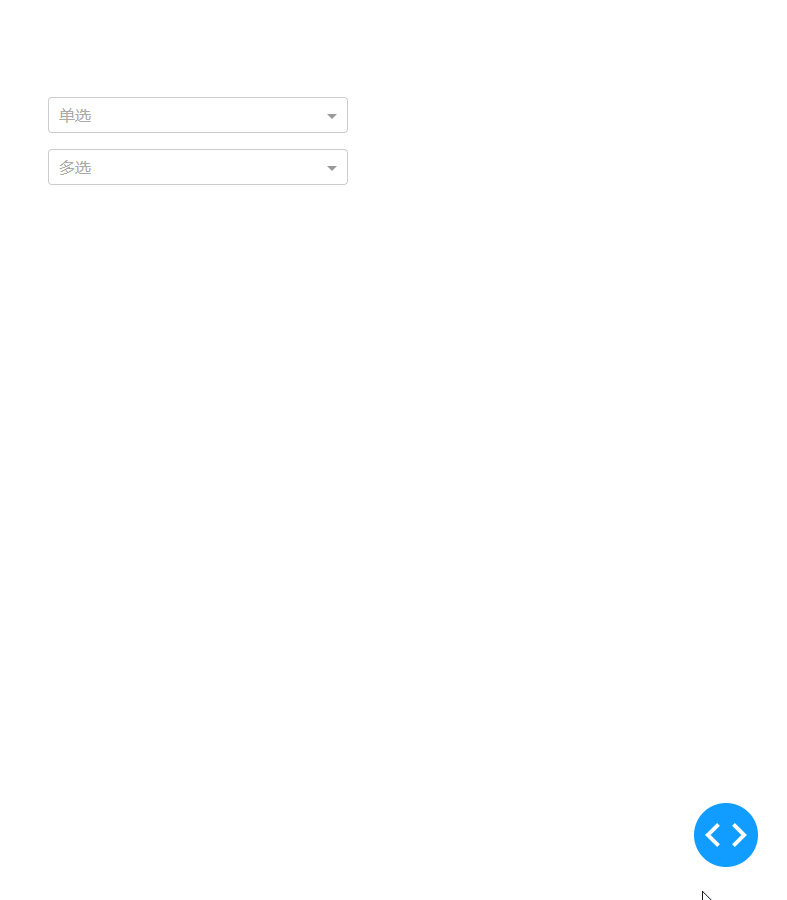
圖4
## 2.3 單選框與複選框
我們分別可以使用`dash_bootstrap_components`中的`RadioItems`與`Checklist`來建立單選框與複選框:
- **單選框RadioItems**
單選框的特點是我們只能在其展示的一組選項中選擇1項。
它的引數`options`格式同`Dropdown()`;
`inline`引數設定為True時會橫向佈局所有選項;
`switch`設定為True時會將每個選項樣式切換為開關;
> app4.py
```Python
import dash
import dash_bootstrap_components as dbc
import dash_html_components as html
from dash.dependencies import Input, Output
import dash_core_components as dcc
import json
app = dash.Dash(__name__)
app.layout = html.Div(
dbc.Container(
[
dbc.RadioItems(
id='radio-items-input',
inline=True,
switch=True,
options=[
{'label': item, 'value': item}
for item in list('ABCD')
],
style={
'width': '300px'
}
),
html.P(id='radio-items-output')
],
style={'margin-top': '100px'}
)
)
@app.callback(
Output('radio-items-output', 'children'),
Input('radio-items-input', 'value')
)
def radio_items_output(value):
if value:
return '已選擇:'+value
return dash.no_update
if __name__ == '__main__':
app.run_server(debug=True)
```

圖5
- **複選框Checklist**
與單選框相對的,是複選框,它的引數與`RadioItems`完全一致,唯一不同的是它是可以多選的:
> app5.py
```Python
import dash
import dash_bootstrap_components as dbc
import dash_html_components as html
from dash.dependencies import Input, Output
import dash_core_components as dcc
import json
app = dash.Dash(__name__)
app.layout = html.Div(
dbc.Container(
[
dbc.Checklist(
id='check-list-input',
inline=True,
options=[
{'label': item, 'value': item}
for item in list('ABCD')
],
style={
'width': '300px'
}
),
html.P(id='check-list-output')
],
style={'margin-top': '100px'}
)
)
@app.callback(
Output('check-list-output', 'children'),
Input('check-list-input', 'value')
)
def check_list_output(value):
if value:
return '已選擇:'+'、'.join(value)
return dash.no_update
if __name__ == '__main__':
app.run_server(debug=True)
```

圖6
而除了上述兩種供使用者對多個選項進行單選或多選的部件之外,`dash_bootstrap_components`中還有可以建立單個選擇部件的`RadioButton`與`Checkbox`,它們只能進行勾選操作,對應回撥用的的輸入值為`checked`,是個Bool型屬性,用來區分是否被勾選上,這裡就不再贅述。
# 3 動手編寫線上調查問卷
學習完今天的內容之後,我們就可以將它們應用到實際需求中,譬如我們現在需要向其他人發放一份調查問卷,其中涉及到不少輸入文字或單選或多選內容,最後我們還需要將使用者填寫完成的表單內容儲存到本地,用`Dash`就可以很快速地完成這項工作:
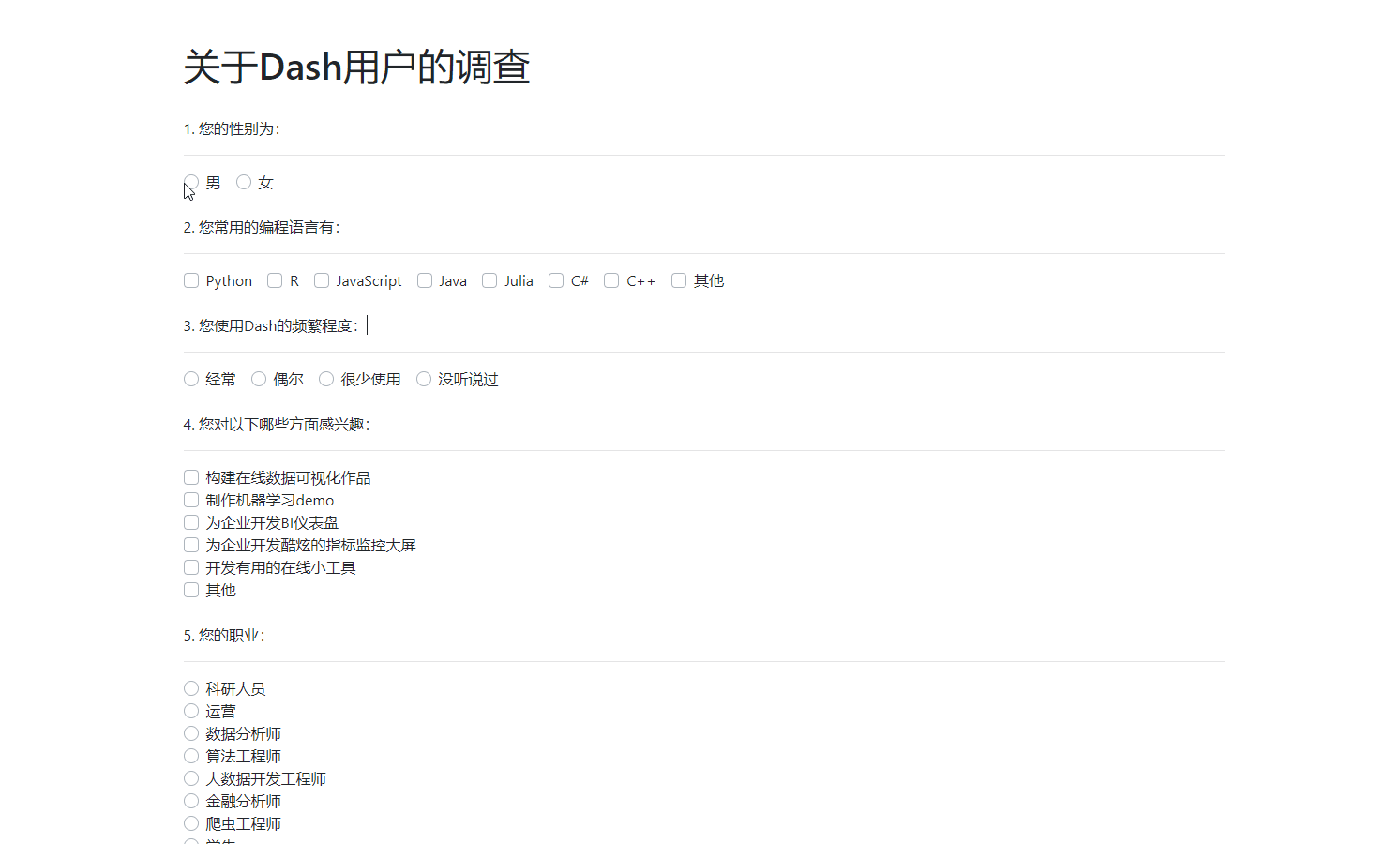
圖7
對應的程式碼如下:
> app6.py
```Python
import dash
import dash_html_components as html
import dash_bootstrap_components as dbc
from dash.dependencies import Input, Output, State
import json
import re
app = dash.Dash(__name__)
app.layout = html.Div(
dbc.Container(
[
html.H1('關於Dash使用者的調查'),
html.Br(),
html.P('1. 您的性別為:'),
html.Hr(),
dbc.RadioItems(
id='gender',
inline=True,
options=[
{'label': '男', 'value': '男'},
{'label': '女', 'value': '女'}
]
),
html.Br(),
html.P('2. 您常用的程式語言有:'),
html.Hr(),
dbc.Checklist(
id='programming-language',
inline=True,
options=[
{'label': 'Python', 'value': 'Python'},
{'label': 'R', 'value': 'R'},
{'label': 'JavaScript', 'value': 'JavaScript'},
{'label': 'Java', 'value': 'Java'},
{'label': 'Julia', 'value': 'Julia'},
{'label': 'C#', 'value': 'C#'},
{'label': 'C++', 'value': 'C++'},
{'label': '其他', 'value': '其他'},
]
),
html.Br(),
html.P('3. 您使用Dash的頻繁程度:'),
html.Hr(),
dbc.RadioItems(
id='frequency',
inline=True,
options=[
{'label': '經常', 'value': '經常'},
{'label': '偶爾', 'value': '偶爾'},
{'label': '很少使用', 'value': '很少使用'},
{'label': '沒聽說過', 'value': '沒聽說過'},
]
),
html.Br(),
html.P('4. 您對以下哪些方面感興趣:'),
html.Hr(),
dbc.Checklist(
id='interests',
options=[
{'label': '構建線上資料視覺化作品', 'value': '構建線上資料視覺化作品'},
{'label': '製作機器學習demo', 'value': '製作機器學習demo'},
{'label': '為企業開發BI儀表盤', 'value': '為企業開發BI儀表盤'},
{'label': '為企業開發酷炫的指標監控大屏', 'value': '為企業開發酷炫的指標監控大屏'},
{'label': '開發有用的線上小工具', 'value': '開發有用的線上小工具'},
{'label': '其他', 'value': '其他'},
]
),
html.Br(),
html.P('5. 您的職業:'),
html.Hr(),
dbc.RadioItems(
id='career',
options=[
{'label': '科研人員', 'value': '科研人員'},
{'label': '運營', 'value': '運營'},
{'label': '資料分析師', 'value': '資料分析師'},
{'label': '演算法工程師', 'value': '演算法工程師'},
{'label': '大資料開發工程師', 'value': '大資料開發工程師'},
{'label': '金融分析師', 'value': '金融分析師'},
{'label': '爬蟲工程師', 'value': '爬蟲工程師'},
{'label': '學生', 'value': '學生'},
{'label': '其他', 'value': '其他'},
]
),
html.Br(),
html.P('您的聯絡方式:'),
html.Hr(),
dbc.Input(
id='tel',
placeholder='填入您的電話或手機號碼!',
autoComplete='off', # 關閉瀏覽器自動補全
style={
'width': '300px'
}
),
html.Hr(),
dbc.Button(
'點選提交',
id='submit'
),
html.P(id='feedback')
],
style={
'margin-top': '50px',
'margin-bottom': '200px',
}
)
)
@app.callback(
Output('feedback', 'children'),
Input('submit', 'n_clicks'),
[
State('gender', 'value'),
State('programming-language', 'value'),
State('frequency', 'value'),
State('interests', 'value'),
State('tel', 'value'),
],
prevent_initial_call=True
)
def fetch_info(n_clicks, gender, programming_language, frequency, interests, tel):
if all([gender, programming_language, frequency, interests, tel]):
# 簡單以寫出到本地指定json檔案為例來演示寫出過程
with open(tel+'.json', 'w') as j:
json.dump(
{
'gender': gender,
'programming_language': programming_language,
'frequency': frequency,
'interests': interests
},
j
)
return '提交成功!'
else:
return '您的資訊未填寫完整,請檢查後提交!'
@app.callback(
[Output('tel', 'valid'),
Output('tel', 'invalid')],
Input('tel', 'value'),
prevent_initial_call=True
)
def check_if_tel_completed(value):
try:
if re.findall('\d+', value)[0] == value and value.__len__() == 11:
return True, False
except:
pass
return False, True
if __name__ == '__main__':
app.run_server(debug=True)
```
---
以上就是本文的全部內容,歡迎在評論區與我進行討論,分享你







